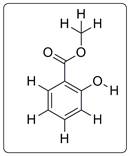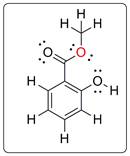
Concept explainers
(a)
Interpretation :
Whether methyl salicylate follows HONC 1234 rule or not must be explained.
Concept Introduction :
HONC 1234 rule is the basic rule for drawing organic molecule. The rule states that H, O, N and C generally form 1, 2, 3 and 4 bonds respectively.
(a)
Answer to Problem 5RE
Methyl salicylate follows HONC 1234 rule.
Explanation of Solution
The structure of methyl salicylate is as follows:

Each carbon has 4 bonds, each O has two bonds and each H has one bond. Thus methyl salicylate follows HONC 1234 rule.
b)
Interpretation :
Molecular formula of methyl salicylate must be written.
Concept Introduction :
Molecular formula is the representation of the molecule which shows the number of total number of different atoms.
b)
Answer to Problem 5RE
Molecular formula of methyl salicylate, C8H8O3 are given below.
Explanation of Solution
In methyl salicylate has total 8 carbons, 8 hydrogens and 3 oxygens. Thus, the molecular formula is C8H8O3.
c)
Interpretation :
Overall shape of the molecule must be explained.
Concept Introduction :
Overall shape of a molecule depends on the total number of electrons including lone pair and bond pair electrons.
c)
Answer to Problem 5RE
Methyl salicylate is planar structure with a tetrahedral methyl group. Here, all the carbon atoms are attached to 4 groups resulting in tetrahedral shape of the molecule.
Explanation of Solution
Methyl salicylate has six membered planar ring in which there are two side chains. One has hydroxyl group and another side chain has methyl ester group. Methoxy group is tetrahedral.
d)
Interpretation :
The oxygen atom must be found which is bonded to two carbon atoms. The reason forthe bond to be bent needs to be explained.
Concept Introduction :
Benting of bond takes place due to repulsion of electron pairs.
d)
Answer to Problem 5RE

The oxygen shown in red is the one which is bonded with two carbon atoms. The bond is bent as there are two lone pairs on electrons. The lone pair-bond pair repulsion results in the bending of the bond.
Explanation of Solution
The oxygen shown in red has two bond pairs and two lone pairs. To minimise the repulsion among these electrons, the bond is bent.
Chapter U2 Solutions
Living By Chemistry: First Edition Textbook
Additional Science Textbook Solutions
General Chemistry: Principles and Modern Applications (11th Edition)
Organic Chemistry
Introductory Chemistry (6th Edition)
General Chemistry: Atoms First
Chemistry: The Central Science (13th Edition)
Chemistry: The Central Science (14th Edition)
 ChemistryChemistryISBN:9781305957404Author:Steven S. Zumdahl, Susan A. Zumdahl, Donald J. DeCostePublisher:Cengage Learning
ChemistryChemistryISBN:9781305957404Author:Steven S. Zumdahl, Susan A. Zumdahl, Donald J. DeCostePublisher:Cengage Learning ChemistryChemistryISBN:9781259911156Author:Raymond Chang Dr., Jason Overby ProfessorPublisher:McGraw-Hill Education
ChemistryChemistryISBN:9781259911156Author:Raymond Chang Dr., Jason Overby ProfessorPublisher:McGraw-Hill Education Principles of Instrumental AnalysisChemistryISBN:9781305577213Author:Douglas A. Skoog, F. James Holler, Stanley R. CrouchPublisher:Cengage Learning
Principles of Instrumental AnalysisChemistryISBN:9781305577213Author:Douglas A. Skoog, F. James Holler, Stanley R. CrouchPublisher:Cengage Learning Organic ChemistryChemistryISBN:9780078021558Author:Janice Gorzynski Smith Dr.Publisher:McGraw-Hill Education
Organic ChemistryChemistryISBN:9780078021558Author:Janice Gorzynski Smith Dr.Publisher:McGraw-Hill Education Chemistry: Principles and ReactionsChemistryISBN:9781305079373Author:William L. Masterton, Cecile N. HurleyPublisher:Cengage Learning
Chemistry: Principles and ReactionsChemistryISBN:9781305079373Author:William L. Masterton, Cecile N. HurleyPublisher:Cengage Learning Elementary Principles of Chemical Processes, Bind...ChemistryISBN:9781118431221Author:Richard M. Felder, Ronald W. Rousseau, Lisa G. BullardPublisher:WILEY
Elementary Principles of Chemical Processes, Bind...ChemistryISBN:9781118431221Author:Richard M. Felder, Ronald W. Rousseau, Lisa G. BullardPublisher:WILEY





